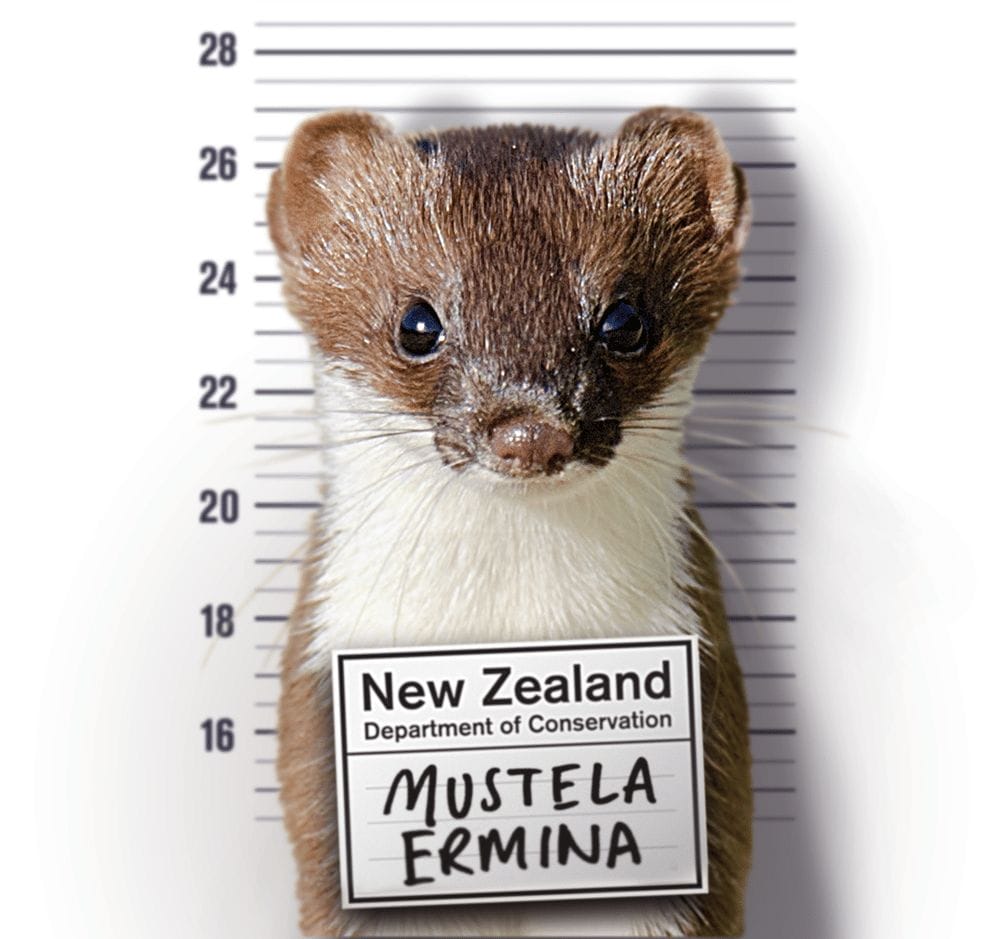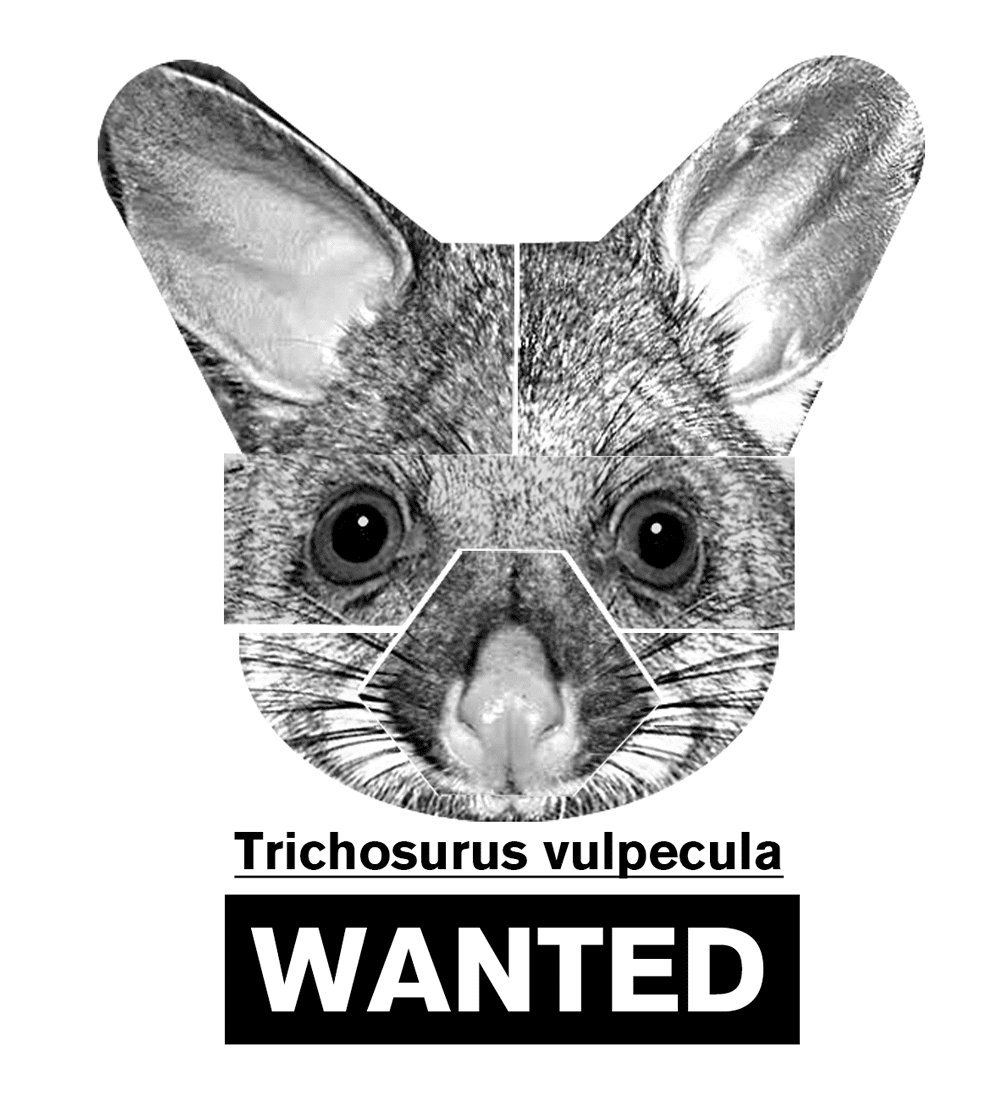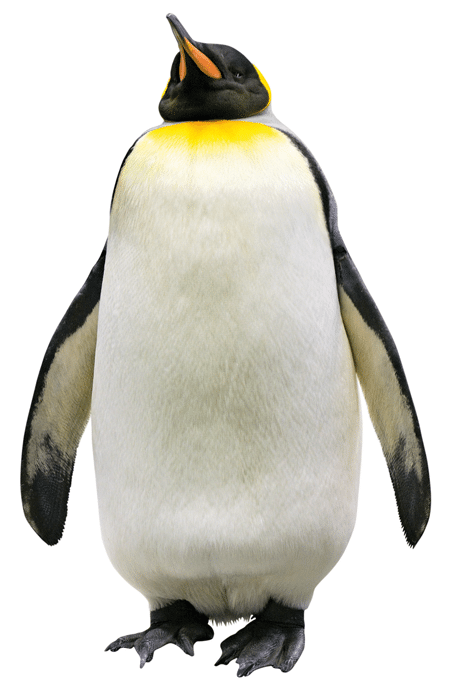Enemy of the stoat
On a visit to New Zealand’s stoat Killing Fields Chris Bourn investigated the country’s double-edged attitude towards wildlife

29th August 2011 (Taken from: #4)
On 29th August 2011 New Zealand waved goodbye to its favourite ever foreigner. Not a visiting rugby player or a Hollywood Hobbit, but an incompetent penguin. For ten weeks a once magnificently stoic nation had gone all Morgan Freeman for “Happy Feet”, a bedraggled emperor penguin found plodding around Peka Peka Beach on the North Island’s Kapiti Coast.
The bird was exhausted and malnourished, having swum some 3,000 kilometres wide of its Antarctic home and eaten a bellyful of sand, mistaking it for snow. The idiot.
Travelling the North Island in August to see some of New Zealand’s rare indigenous wildlife, I was invited to Wellington Zoo to meet Mr Feet, adopted national hero. It was three days before he was due to hop on a boat back to Antarctica, and an audience with him was by now something of an honour. Here was a penguin that had been given better medical care than many New Zealanders have access to, in the zoo’s dedicated bird hospital; whose daily fish consumption was being closely monitored by the national press; whose story had even prompted a Facebook campaign, backed by an MP, to appoint him as a last-minute ambassador for the Rugby World Cup – despite being only partially black.
You might get the full red-carpet treatment if you’re a metre-high penguin, but if you’re one of any number of non-waddling, non-native species to have pitched up on these islands, you’ll be shown no mercy”
Inside the zoo, a harried-looking PR person conducted me to a section of the bird-hospital complex away from public view. The metal door to Happy Feet’s ice-pen swung open, ‘X Factor’-style… He was… a bird. He didn’t even seem that happy. With the onset of the southern spring, Wellington was becoming uncomfortably warm for him, and he was sprawled on his tummy, trying to get as much ice-on-feather contact as he could. Most undignified. As I tried to formulate the appropriate diplomatic greeting, a pair of vets bundled past to give him a hose-down, and I was ushered away.
“Happy Feet came to our shores, not feeling so great – we welcomed him with open arms,” was how the Facebook campaign had it. “He’s a clean, green symbol of New Zealand and our people, our welcoming and friendly nature and our all-embracing hospitality.”
Except the rest of my tour told a very different story. You might get the full red-carpet treatment if you’re a metre-high penguin, but if you’re one of any number of non-waddling, non-native species to have pitched up on these islands in the past 200 years – a possum, rat, stoat, ferret, deer, wallaby or feral cat – and if you break cover, you’ll be shown no mercy. In its forests and islands, farmlands and fjords, New Zealand is waging total war against furry aliens. And I was there, embedded with frontline patrols, to witness it.
The battle for the islands
Kapiti Island lies 5.2km off the North Island’s lower west coast, directly opposite the spot where Happy Feet’s rescuers picked up their penguin – and it’s an island under siege. The whole outcrop is an asylum for indigenous birdlife, a rangy natural aviary that was wiped clean of rats, mice and possums in the ’80s and ’90s.
It is now rigorously managed by the Department of Conservation (DoC) in partnership with the island’s tiny Maori community, and is home to some of New Zealand’s rarest endemic birds: takahe – purple-plumaged mega-coots, of which only around 200 exist in the world; saddlebacks – a thrush-like wattlebird with a crimson handlebar moustache, which only narrowly escaped extinction in the 1960s; and a thriving population of around 1,200 little spotted kiwi, a variety of the national mascot that has been extinct for over a century on the mainland.
Before I am permitted to disembark on Kapiti’s pebbled shore, I have to undergo two thorough bag and pocket searches for crafty rodent stowaways. Tough biosecurity checks are always in place here, but on my visit it’s likely they are tighter than usual – because since December 2010 three stoats have been discovered dead in traps in this supposedly predator-free habitat. As a result, the New Zealand media are currently on high stoatwatch alert and the island is in lockdown. The DoC is wary of exciting further alarm, but on the quiet is convinced there are more invaders hidden out here somewhere, in the 20 square kilometres of rolling scrub.
Andrew Veale, a researcher into stoat DNA at Auckland University, and a key figure in the country’s intelligence campaign against introduced predators, explains the national state of anxiety: “Here stoats are apex predators. They’re the equivalent of the lions of the Serengeti. On previous islands, such as Maud Island, a single female stoat has arrived, had a litter and destroyed an entire population of saddleback.”
Veale’s PhD thesis is entitled ‘The Molecular and Invasion Ecology of Stoats on New Zealand’s Islands’, so he should know. He elaborates: “Unfortunately New Zealand [was] separated for 80 million years from mammals – and so when threatened our birds get on the ground, get silent, don’t move. Now that’s fine if your predator is a falcon. But if it is a rat or a stoat, it’s sensing you by smell; if you go into your nest or hole to be safe, it comes in the nest with you. There’s very little chance you’re going to survive.”
I don’t see any saddlebacks on my visit. But I do encounter plenty of other exotic species, and they do indeed seem especially naive. After sundown I get close to a couple of the nocturnal kiwi, courtesy of Kapiti Island Nature Tours, an outfit run by one of Kapiti’s residents which has a special licence to chaperone visitors around the island. The torchlit kiwis, bigger and nimbler than I’d imagined, seem comfortable in our presence for a minute or so despite their shy reputation. And the next morning three bumptious takahe descend on the lodge like a gang of unannounced aunties, pecking round the kitchen door for scraps.
Along with ferrets, stoats were deliberately introduced to New Zealand from Britain in 1884, in an attempt to constrain the (also introduced) rabbit population. Their power and adaptability as predators was wildly underestimated then, and continues to be today. “If stoats can actually swim 5.2km,” says Veale, “that means that Kapiti Island is not safe after all.” His hypothesis of a volitional invasion remains a cautious one – many biologists are sceptical that such a small mammal could swim out to sea that far and survive. But it’s based on knowing his enemy intimately: “In New Zealand they’ve been recorded on over 90 islands now… One recently re-incurred on Rangitoto Island near Auckland, where everything had been eradicated in 2009. They thought this stoat was a survivor, because it was assumed it was too far offshore. But I did the genetics, and it definitely came from the mainland – which is 3km away.”
“I do see them as the enemy,” says Veale, “but I have huge respect for them – they are very charismatic.” He’s also a big fan of rats – when they’re not trespassing on his ecosystems – which he’s kept as pets in the past. But, he admits, “You cannot catch and keep a stoat as a pet… They’re kind of unpleasant.”

Chemical warfare
It’s thought that at least 50 native bird species have been bullied into oblivion since people arrived in New Zealand, bringing their pets and pests with them. The first wave of furry interlopers were kiore, a type of rat which disembarked canoes with the Maori around 800 years ago. But the truly devastating inundation came with the Europeans, from the early 1800s onwards: aside from mustelid species, ship rats, house mice and Australian brushtail possums top the list of aggressive nest predators. Possums also compete with birds for denning holes and tear up the indigenous plant life to the point of destruction, irrevocably denuding native habitats. Other introduced species that DoC classifies as shoot-on-sight pests include rabbits, hedgehogs, deer and wallabies. Basically it’s Beatrix Potter’s back catalogue, plus Roo.
Unlike most countries, where the public may be squeamish about exterminating unwanted fuzzies, New Zealand, says Andrew Veale, “has some very good, clear distinctions: if it’s got fur, it’s not meant to be here. There’s an interesting thing in the New Zealand psyche – the demonisation of our pest species. If you’re driving in many parts of the country you’ll commonly see possums dead on the road. People aim for them.”
Battle-hardened public opinion is, in many ways, what allows the DoC to engage in mass pesticide. New Zealand currently consumes roughly 90 per cent of the world’s supply of the poison sodium fluoroacetate, aka ‘ten-eighty’. And according to a senior scientist I spoke to at DoC, the Kiwis are way ahead of the game in developing new strategies for massacring wildlife.
“It’s sort of a bit sad, really,” she says. “If you’re a scientist for the Department of Conservation your main job is killing things. It’s awful!” She laughs. Then sighs. “But what I’m involved in is trying to kill things more humanely; it’s not those animals’ faults they are here. So we are looking at developing new toxins – and we’ve actually just got this new one registered in New Zealand, which is the first toxin registered for mammal pests anywhere in the world for about 20 years.”
The new poison, PAPP (which stands, mercifully, for para-aminopropiophenone), could well prove revolutionary, as it’s designed to work on stoats and feral cats – animals that usually turn their noses up at dosed pellets. Instead, death will be dealt via innovative machines the DoC team are developing called Spitfires. The poison is delivered by nozzles primed to squirt stoats’ bellies with toxic paste as it walks over them; when the stoat licks off the PAPP it acts on haemoglobin like carbon monoxide, causing the stoat to fall asleep within 20 minutes, and killing it within an hour.
The Spitfire’s real strength, though, is its self-resetting capability: it’s hoped that one machine will discharge 100 times before it needs a reload. Currently DoC relies on mechanical, single-fire “kill-traps”, which are spread over approximately 100,000 hectares on the North and South Islands; each trap has to be cleared and reset manually every time a hapless animal triggers it. Nationwide this system often fails to keep pace with pest population surges, and is an enormous drain on government resources. Like its aeronautical namesake in the ’40s, though, the Spitfire might well be the technological advance that rolls back invasion. And it’s just part of a whole suite of exciting new extermination hardware the New Zealand government is currently looking at: self-resetting kill-traps that can fire a dozen times in succession; traps with image recognition that target specific species; even iPhone app-traps that will send you a text message each time they make a kill, presumably with a customised message: STOATIE DON’T SURF }; )

Behind enemy lines
Remote, rugged and other-worldly, the Te Urewera ranges in the central North Island are one of the largest expanses of native forest remaining in New Zealand. Their survival has largely been down to the stewardship of the region’s Maori tribe, the Tuhoe. Ever since they were left off the signatory list for the Treaty of Waitangi in 1840, the tribe has had a stormy relationship with the Crown. As recently as 2007 the community suffered a series of police raids on Tuhoe homes and schoolbuses, in which 18 people were arrested – the authorities apparently identifying them as organisers of a separatist training camp somewhere in the mountains. Charges of terrorism were later massively downgraded to possession of firearms, and then mysteriously dropped for all but four of the accused, without explanation or apology from the authorities.
“In a culture where there are pigs and deer in the forest, every family owns firearms,” says Joe Doherty, a member of the Tuhoe tribe who grew up in the region and who now runs its only touring operation, Te Urewera Treks. Joe and I have stopped for a map-check on a trail leading us deep into the Whirinaki Forest Park, the Tuhoe-owned portion of Te Urewera. We’re on the first leg of a two-day riverside tramp into what’s beginning to feel like the Kiwi version of ‘Heart of Darkness’. Joe continues: “Some of these firearms have been passed down through several generations, so they’ve never had gun licences.”
Whatever antagonisms might persist between Tuhoe and state, though, both sides are allied in a struggle against a much fiercer, wilier enemy. As Joe and I press deeper into the primeval tree-ferns and monolithic podocarp trees it soon becomes clear that Te Urewera is a frontline arena in New Zealand’s war against fur.
Joe stops to examine stoat tracks in the mud. “You see how the foliage is flattened all the way down to the river? That’s a little stoat highway.” Every 20 metres or so, we encounter a trap just off the trail: wooden shoeboxes with wire-mesh façades designed to admit only skinny, ravenous quadrupeds – and not to let them out again. These are ‘DoC 200’ kill-traps – Swedish-designed critter coffins that work by luring their target inside with rabbit bait, then firing a spring-loaded steel “masher” straight down on its head.
The first few boxes are empty. But it’s not long before I sight my first enemy casualty, a rat. Two traps on and there’s a stoat lying prone, with the fuzzy black tip of its tail poking out through the mesh, its neck vanishing into the thin gap between two metal presses. For such an unwelcome incomer, it’s actually quite an endearing thing: a slick ginger otter, 30cm long, with athletic poise and a long, gracefully arcing neck. If it weren’t for the crushed head it would look the part in a little tutu.
Shoot-on-sight pests include rabbits, hedgehogs, deer and wallabies. Basically it’s Beatrix Potter’s back catalogue, plus Roo”
Hugging the Whirinaki River valley, the trail climbs steeply – and so does the bodycount. Gazing into a wall of serene greenery on the opposing slope, it’s hard to imagine a more peaceful wilderness existing anywhere on earth. But down by our feet it’s carnage. At this elevation just about every DoC 200 contains at least one carcass, occasionally two – mustelids mostly, the odd rodent; by the time we reach camp I make it one-and-a-half fur coats’ worth.
Back on the trail the next day, Joe illustrates the catastrophic effect that pest incursion has had on the local birdlife. By the river he spots a plump New Zealand wood pigeon perched on a branch, glorious in its purple-green paua-shell plumage. “Kereru… kereru…” – Joe calls to it softly using its Maori name. The species used to be a staple of the Tuhoe diet, he tells me, until the tribe called a moratorium in the ’70s when the bird’s numbers went into sharp decline. The environmental agency Landcare Research recently interviewed tribal elders to get a sense of what the kereru population was like in the early twentieth century. “They said they remembered hunters with spears going up into trees and birds landing on their shoulders they were so plentiful,” he says. Joe himself remembers flocks of 70 or 80 when he was growing up in the 1960s; “Now you’d be lucky to see seven together.”
Further on we disturb two bush-pigs (apart from one type of venomous spider, the closest thing New Zealand has to a dangerous wild animal), which trot away from us like angry bloated ponies; another gift to the ecosystem brought by the colonisers. And further on again a scattering of grey feathers, probably torn from a friendly North Island robin, tells a sad story; feral cats, Joe confirms, are one more threat the native bird populations are failing to cope with.
In two days in the bush, the only other soul we meet is a Maori man in green DoC fatigues. A dog scampers beside him and he clutches a brace of crunched stoats by the tails. In lieu of a salute, we nod. He flashes a comradely greeting back, but his eyes are somewhere else. They’re eyes that have seen too many mashed mustelid faces today. Too many wasted whiskers.
Happy Feet: MIA
 On 4th September 2011, after six days aboard the research vessel Tangaroa, Happy Feet was coaxed on to a plastic chute and slid, flippers first, into the 8m swells of the sub-Antarctic seas. Technically he had represented an invasive species, but New Zealanders, with their instinctive bias towards birds, were cheering him on all the way. In order that his quarter of a million online followers could chart his progress south, the penguin had been fitted with a GPS tracking device, superglued to his feathers. After the release, Dr Lisa Argilla, the vet who nursed him back to health and escorted him on his return trip, blogged a parting message from onboard the ship: “Find some mates, and please stay away from those orcas and leopard seals!!”
On 4th September 2011, after six days aboard the research vessel Tangaroa, Happy Feet was coaxed on to a plastic chute and slid, flippers first, into the 8m swells of the sub-Antarctic seas. Technically he had represented an invasive species, but New Zealanders, with their instinctive bias towards birds, were cheering him on all the way. In order that his quarter of a million online followers could chart his progress south, the penguin had been fitted with a GPS tracking device, superglued to his feathers. After the release, Dr Lisa Argilla, the vet who nursed him back to health and escorted him on his return trip, blogged a parting message from onboard the ship: “Find some mates, and please stay away from those orcas and leopard seals!!”
“Oh no, I dreaded it,” recalls our contact at the DoC. “When they put that transmitter on, I thought that was not a good move…” Sure enough, five days later the signal went ominously silent. Did Happy Feet, having spent so long in New Zealand, share the fate of so many of its birds and become an easy feast for a passing predatory mammal? If so, the NZ$30,000 spent on his recuperation could have made him the most expensive meal a killer whale’s ever eaten.
Feet’s Kiwi fanbase might find some consolation in the thought that he would have at least taken his rightful place in the food chain, prey for a hunter with full evolutionary jurisdiction over the emperor penguin’s natural habitat. A fair cop, you’d have to admit. Unless, of course, those stoats can swim even further than we thought…
Slow Journalism in your inbox, plus infographics, offers and more: sign up for the free DG newsletter. Sign me up
Thanks for signing up.








